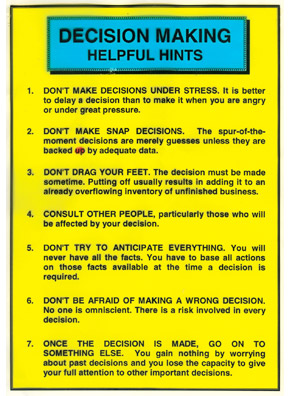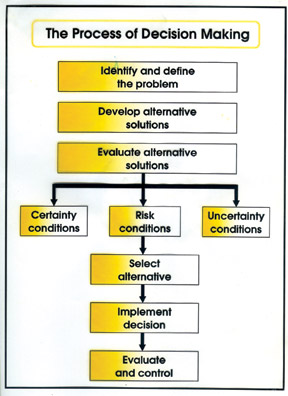|
Decision making in organizations:
Problem solving methods and techniques
Dr K Kuhathasan
CEO: CENLEAD
The word 'problem' refers to the uncertainties or difficulties
(obstacles) encountered in getting from one situation to a preferred one
(the objective). We use it loosely to describe any circumstances, real
or imaginary, which we think could be improved.
 Problem solving is the act of narrowing the gap between the two
states with a course of action which achieves, or comes closer to, the
desired objective. Problem solving is the act of narrowing the gap between the two
states with a course of action which achieves, or comes closer to, the
desired objective.
It is a process of transforming one situation into another by
removing, over-coming or navigating around obstacles.
Problems can be divided broadly into two groups. Maintenance problems
exist where the current situation is not as it should be. This may be
the result of something failing to happen as expected, or something
happening that should not have happened, ie there is a deviation from
the 'norm'. The failure of a supplier to deliver on time and the
breakdown of a production line, for example are both maintenance
problems.
The second group is achievement problems, where the current situation
could be better but there are reasons why it is not. These can be
subdivided into three groups:
* Where the current objective has not been achieved (eg) failure to
achieve a sales target.
* Where the current objective could be exceeded, (eg) improving
response to a sales promotion.
* Where an opportunity exists (eg) creating a new product or service
to increase
* Sales revenues.
Problems solving is valuable in situations other than when things are
not as they should be. It can help us find ways to improve performance
and exploit opportunities by setting new objectives.
In competitive situations it is vital that we continually improve
upon the status quo.
Innovation through problem solving help individuals and organizations
find new, more efficient ways to operate in complex and rapidly changing
environments.
Flexibility is essential to achieve such benefits. We need to
understand the problem-solving process and systematically apply the
skills and techniques appropriate to each problem.
Thinking skills
Problem solving involves mentally manipulating information using both
analytical and creative thinking skills. Analytical or logical thinking
includes processes such as ordering, comparing, contrasting, evaluating
and selecting.
 It often predominates in solving maintenance problems, where several
potential causes may have to be eliminated to identify the actual cause. It often predominates in solving maintenance problems, where several
potential causes may have to be eliminated to identify the actual cause.
Creative thinking, as the term implies, uses the imagination to
create ideas. It involves looking beyond the obvious, bringing together
disparate ideas and making connections to spark new ways of looking at
this.
There is a large element of creative thinking in solving achievement
problems. It has four main dimension:
Fluency: Case of producing ideas;
Flexibility: Case of modifying and adapting ideas;
Originality: The freshness or novelty of ideas;
Elaboration: Expanding and detailing ideas.
Effective problem solving involves a mixture of analytical and
creative thinking. Ideally we would be able to switch easily from one
style of thinking to another.
This is not always easy. Our formal education pays much more
attention to the development of analytical skills and logical thinking
dominates in our work.
The result is that often we find it difficult to escape the
analytical mind-set to a more free-flowing, creative style of thinking.
However, there are techniques, described later, which help us make this
switch.
Other skills are also required in solving problems effectively.
Interpersonal skills, for example, may be essential where the problem or
its solution involves or affects other people.
The ability to work in a team, to be open to other viewpoints and to
resolve conflicts constructively can all be important. The management of
resources may also play a key role in finding solutions and implementing
them. This paper concentrates on the thought processes involved, but
other skills, knowledge and attitude are equally important in problem
solving.
Why problems?
* Not being methodical.
* Lack of commitment to solve the problem.
* Misinterpreting the problem.
* Lack of knowledge of the techniques and processes of
problem-solving.
* Inability to use the techniques effectively.
 * Using a method inappropriate for the particular problem. * Using a method inappropriate for the particular problem.
* Insufficient or inaccurate information.
* Inability to combine analytical and creative thinking.
* Failure to ensure effective implementation.
Using your brain
Your brain has two sides. Each side controls certain body and
thinking functions. The left side of the brain is in charge of
analytical thinking, logic. It takes you through well-ordered steps and
makes you the genius.
The right side operate in images and impressions, rather than numbers
and words. Creativity originates in the right brain.
The chart below shows how the two sides of your brain divide and
conquer the unfathomable task of thinking you through life. Good problem
solvers need to draw on both sides of the brain.
Right - and left - brain comparisons
* Left Brain
* Seeks one right answer
* Recognizes words
* Processes our stimulus at a time at lightning speed.
* Orderly sequence of thought
* A focus on parts
* Logical
* Linear thinking
* Organizes into units
* Governed by rules, plays by rules
* Draws on learned, fixed codes
* Organized
* Can recall complex sequences
* Best in implementing programs after set up
Right brain
Explores, seeks, examines from many viewpoints
* Recognizes facts or objects
* Processes whole clusters of stimuli all at once
* Grasps complex wholes
Takes in whole picture
 * Dreams * Dreams
* Makes sense by discovering workable patterns
Can connect part of the world into fresh patterns
* Follows few rules
* Can deal with new information where no learned program is available
* Sees correspondence or resemblances Thinks in complex images
* Best in initial orientation of a task
Solving problems in a group
A lot of problem solving take place in group settings. Meetings and
informal discussions, for example, are often used to air different ideas
and points of view to help solve problems for which participants have
either shared responsibility or a contribution to make. Most of the
time, however, we don't take full advantage of group settings. It can be
the best way to solve some problems but only if it is used properly.
When to use group problem solving
There are definite advantages in using a group to solve certain
problems, but others can be solve more effectively by an individual. It
is important to know when and where not to work in a group. The
following checklist can help you to decide.
* Can the problem be defined in many different ways?
* Is information form many different sources required?
* Is it a specialized problem, where the 'expert' might be biased or
not see the wider implications?
* Does the problem have implications for many people?
* Are there likely to be many possible solutions?
Potential drawbacks
* Competition
* Conformity
* Lack of objective direction
* Time constraints
Benefits and potential drawbacks of group problem solving
Benefits
* Greater output
* Cross-fertilization
* Reduced bias
* Increased risk taking
* Higher commitment
* Improved communication
* Better solutions
In the groups
* Identify the problem
* Negotiate
* Brainstorm many options
* Select the best option
* Think creatively
* Think logically
* Analyze the problem
* Research
 * Form a hypothesis * Form a hypothesis
* Troubleshoot
Problem-solving approach
The ability to use a prescribed method of resolving conflict that
focuses on solving problems is important for effective coaches. The
four-step process below can help you to reduce conflict and solve
problems.
Acknowledge the conflict
* Schedule a meeting
* Determine own conflict resolution style
* Determine other person's style
* Decide to discuss the conflict
Discuss the conflict
* Decide what questions to ask
* Be prepared to listen
* Do you know what your point of view is?
* Do you understand the other person's point of view?
Agree on a solution
* Discuss alternatives
* Decide on mutually acceptable solution
* Decide how to implement the solution
Monitor results
* Decide how you will verify that the solution is implemented
* Ensure conflict is resolved to everyone's satisfaction
* Determine if anything else needs to be done.
|



